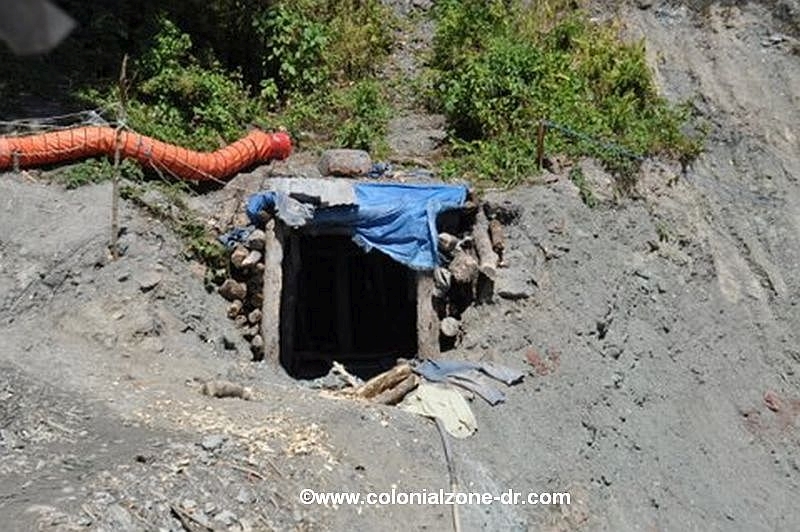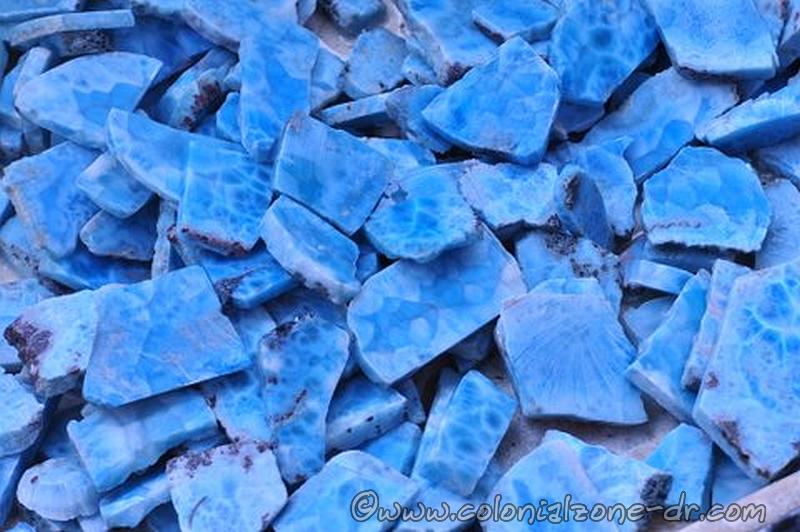Larimar From Dominican Republic
Larimar is a beautiful stone only found in the mountain area of Barahona, Dominican Republic. Larimar is found under the ground in deep mines. This rare stone is the color of the Caribbean Sea on a bright sunny day.
About Larimar | The Mines of Barahona | Gift Shops | The Powers of Larimar | Purchase Larimar

About Larimar
Volcanos many millions of years ago formed Larimar. Larimar is a type of Blue Pectolite that can be found all over the world, in Canada and the U.S.A. But, only Dominican Republic produces the rare variety known as Larimar. Larimar often has a white spider-veined look to it. It is very abundant in the Dominican Republic, for now. It can only be found in the mountains of the Barahona in the Southwest region of the country. Los Chupaderos, in the Los Checheses area. This is the only place where this gem appears on the terrestrial crust. When these mines have been depleted of this rare stone it may be gone forever.

It was originally thought that Larimar came out of the sea as pieces flowed down the river into the sea where they were originally found. There were mentions of this beautiful blue stone throughout history (The first written mention of the “blue stone” is when Father Miguel Domingo Fuertes Loren, November 1916, asked for permission to explore more for this rock he found. It was never mentioned in geological studies or literature and was forgotten).

In 1974 a Peace Corps member and a Dominican man, Miguel Méndez, located the source of the stone thus the name Larimar came into existence. Miguel Méndez’s daughter’s name was Larissa and the Spanish name for the sea is Mar. So the name Larimar was born.
Larimar also has been given different names over the years including Caribbean Turquoise and The Dolphin Stone.
Here are some good looking pieces of Larimar jewelry for sale at Amazon.com

The Mines
If you should decide to make a trek to visit the Larimar mines in the mountainous area of Barahona it is a great experience. These mines can only be accessed by long, bumpy, rocky and dusty roads and the trip is not an easy one. If you make this trek you will feel as if you were going back in time. It would be a truly memorable experience.
The larimar mines are long, deep holes in the ground formed by the chimneys of the volcano. The mining is very dangerous and done primitively using manual labor. These local miners have no modern tools to extract the Larimar. There are no safety measures takes in the mines here in the country so there are many collapses and many lives have been lost. Most of these miners live near the mines in small villages and have done this work their entire lives.

Gift Shops
Larimar jewelry can be found in gift shops and jewelry stores throughout the Dominican Republic. Larimar jewelry is one of the tourists’ favorite purchases when visiting the country.
Larimar is graded according to its colors. The volcanic blue color is considered high quality. The cheaper jewelry coloring is usually white to light blue. The green-colored stones are lower quality also unless the green is very intense.

To see some great examples of larimar make sure to visit the Larimar Museum on Calle Isabel la Católica near Padre Billini in Colonial Zone. Also, almost every gift shop will have some larimar jewelry for sale in a wide price range.
Larimar is rated between .5 and 7 on the Mohs Scale of Hardness.

The Powers of Larimar
The cosmic powers of Larimar are said to help one view events from a different perspective. The color of Larimar looks like the sky blending into the sea with a touch of clouds or foam. Water and air are the most changeable of the physical elements. Its cool and calming color helps teach us how to change anger into a more peaceful form of feeling expression. It softens, enlightens and heals in a physical, emotional, mental and spiritual way.
Larimar is said to stimulate the heart, throat, third eye and crown chakras helping with inner wisdom and outer manifestation of this wisdom. It represents peace and clarity. It radiates healing and love energy. It is recommended for people who are stressed. Larimar helps a person to communicate from the soul thus promoting the flow of expression and creative ideas yet its grounding qualities help one to make these ideas turn into reality.
Larimar tells us that life, like the skies and seas, is always changing and in chaos yet underneath this seemingly chaotic exterior is the peace of the eternal soul.

Purchase Larimar
If you cannot make the trip to come to the Dominican Republic to purchase your own larimar you can always buy it online at Amazon. There is a wide variety of beautiful pieces from which to choose. Here are just a few samples.
Beautiful Dominican Republic larimar from Amazon












